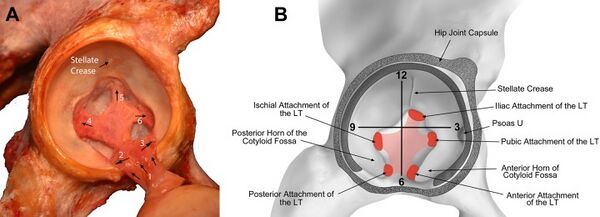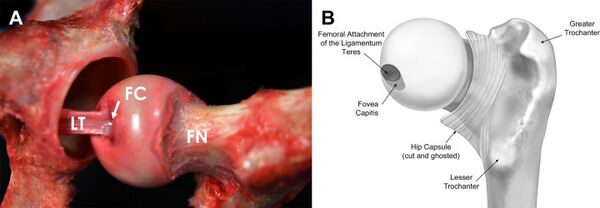Ligamentum Teres
This article or area is currently under construction and may only be partially complete. Please come back soon to see the finished work! (13/02/2024)
Original Editor - Carina Therese Magtibay
Top Contributors - Carina Therese Magtibay
Description[edit | edit source]
The Ligamentum Teres, also known as ligamentum femoris capitis, is an intra-articular extrasynovial ligament that has acetabular and femoral attachments.[1]
Earlier research have described it as a vestigial structure due to its slack state during distraction and surgeons have promoted its excision during procedures such as reduction of dislocations in developmental dysplasia of the hip and surgical hip dislocations.[2][3]
On the other hand, more recent studies have suggested the ligamentum teres to have an important function in proprioception, nociception, and as a secondary stabilizer of the hip joint. [4][5][6]
Attachments[edit | edit source]
Origin: acetabular fossa and transverse acetabular ligament

Insertion: fovea capitis of the posteroinferior aspect of the femoral head
Function[edit | edit source]
Clinical Relevance[edit | edit source]
Assessment[edit | edit source]
Treatment[edit | edit source]
Resources[edit | edit source]
References[edit | edit source]
- ↑ Rosinsky PJ, Shapira J, Lall AC, Domb BG. All about the ligamentum teres: from biomechanical role to surgical reconstruction. JAAOS-Journal of the American Academy of Orthopaedic Surgeons. 2020 Apr 15;28(8):e328-39.
- ↑ Ganz R, Gill TJ, Gautier E, Ganz K, Krügel N, Berlemann U. Surgical dislocation of the adult hip: a technique with full access to the femoral head and acetabulum without the risk of avascular necrosis. The Journal of Bone & Joint Surgery British Volume. 2001 Nov 1;83(8):1119-24.
- ↑ Gray AJ, Villar RN. The ligamentum teres of the hip: an arthroscopic classification of its pathology. Arthroscopy: The Journal of Arthroscopic & Related Surgery. 1997 Oct 1;13(5):575-8.
- ↑ Mikula JD, Slette EL, Chahla J, Brady AW, Locks R, Trindade CA, Rasmussen MT, LaPrade RF, Philippon MJ. Quantitative anatomic analysis of the native ligamentum teres. Orthopaedic Journal of Sports Medicine. 2017 Feb 24;5(2):2325967117691480.
- ↑ Van Arkel RJ, Amis AA, Cobb JP, Jeffers JR. The capsular ligaments provide more hip rotational restraint than the acetabular labrum and the ligamentum teres: an experimental study. The bone & joint journal. 2015 Apr 1;97(4):484-91.
- ↑ Martin HD, Hatem MA, Kivlan BR, Martin RL. Function of the ligamentum teres in limiting hip rotation: a cadaveric study. Arthroscopy: The Journal of Arthroscopic & Related Surgery. 2014 Sep 1;30(9):1085-91.







